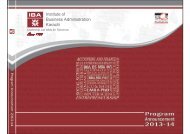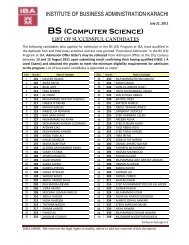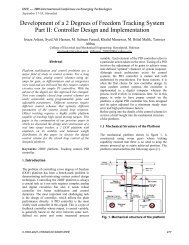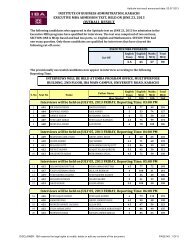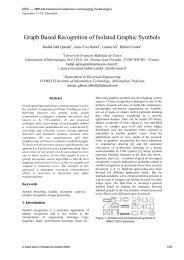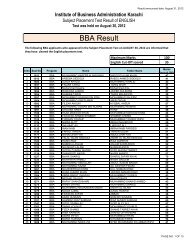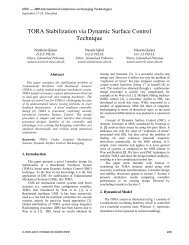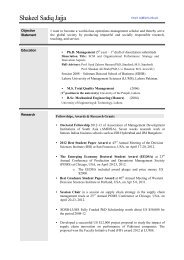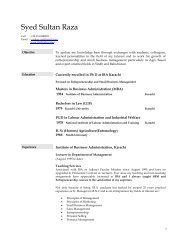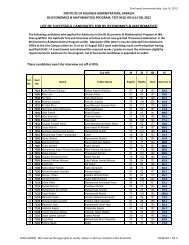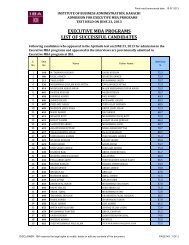Adnan Ahmed Khan, Sajid Bashir, Syed Ismail Shah
Adnan Ahmed Khan, Sajid Bashir, Syed Ismail Shah
Adnan Ahmed Khan, Sajid Bashir, Syed Ismail Shah
You also want an ePaper? Increase the reach of your titles
YUMPU automatically turns print PDFs into web optimized ePapers that Google loves.
September 17-18, Islamabad<br />
sequence more stable is the correlation curve, whereas with<br />
shorter PN codes the MAI behavior becomes increasingly<br />
random.<br />
The soft decision at the end of the Matched Filter is also<br />
effected by the number of chips per symbol and it moves<br />
away from the correct symbol in the constellation diagram<br />
with decrease in number of chips per symbol as observed<br />
in figure 7. It can also be deduced that the longer the<br />
spreading sequence more is the error margin available<br />
hence reducing the effects of MAI.<br />
4.3 Number of users<br />
With the increase in number of users cumulative C x,y<br />
Eq.(5) increases the variation in MAI. Figure 8 and figure<br />
9 show the designed cross correlation values for a<br />
reference user with that of other users for with spreading<br />
gain of 64 chips figure 8 and spreading gain of 128 chips<br />
figure 9. The first value being the auto-correlation of the<br />
reference user’s spreading code with itself resulting in a<br />
peak. Rests of the values are the cross-correlations with the<br />
remaining users. The difference between the autocorrelation<br />
and cross correlation is the available margin for<br />
error.<br />
It can be seen that the cross-correlation values for<br />
different users may be positive or negative which depends<br />
upon the assigned spreading codes. In case of BPSK (the<br />
modulation technique for our simulation) the data bit may<br />
only invert the cross correlation. If data bit is ‘0’ the<br />
transmitted signal is the same assigned spreading code and<br />
for data bit ‘1’ the spreading code is inverted. This<br />
inversion modulation changes the polarity of the resulting<br />
cross correlation. Assuming each user transmits data bit ‘0’<br />
the cross correlations at the receiver will be the same as<br />
that of the transmitter. In this case all those users having<br />
cross correlation in the same coordinates as the reference<br />
user will correlate constructively while the users from other<br />
half will correlate destructively. The available data for<br />
decision at the receiver is [6].<br />
Y<br />
∑<br />
= Akdk<br />
+ i,<br />
k + 1/ Tb<br />
n(<br />
t)<br />
gk(<br />
t dt<br />
k )<br />
We can re-write this equation as.<br />
Y<br />
or<br />
IEEE --- 2005 International Conference on Emerging Technologies<br />
∫<br />
ρ (8)<br />
∑dnkAndn<br />
+ ∑ dmkAmdm<br />
+<br />
= AkdK<br />
+<br />
n<br />
k (9)<br />
MAI MAI + MAI<br />
k = n m<br />
(10)<br />
Where ‘n’ users correlate constructively and ‘m’ is the<br />
total number of users which correlate destructively. The<br />
MAI to be eliminated for getting correct decision is only<br />
MAI m i.e the destructive interference. In a constellation<br />
diagram for BPSK we have a single decision boundary for<br />
the two transmitted symbols. The users with MAI n that<br />
result in constructive interference will force the estimated<br />
symbol away from the decision boundary deep into the<br />
correct decision region. Whereas the users that result in<br />
MAI m will drag the decision out of the correct decision<br />
region. The identification of users causing destructive<br />
interference will not only reduce the complexity of the<br />
MUD algorithm but will also reduce the computational<br />
overheads. Figure 8 and 9 differentiates between the users<br />
causing the two types of MAI. The worst case scenario of<br />
MAI is seen when all the users are causing destructive<br />
interference as shown in figure 10 that depicts an increase<br />
in MAI with increase in the number of users. Where as for<br />
a practical scenario when random data is transmitted by<br />
each mobile user the behavior of MAI curve is not linear as<br />
observed earlier.<br />
The algorithm shown below, if used before MUD can be<br />
helpful in deciding weather MUD is indeed required or it<br />
can be avoid, thus reducing computational complexity of<br />
the system. When the two positive and negative MAIs are<br />
equal they cancel each others effects, therefore there is no<br />
need for MUD algorithm. In the second case the MUD will<br />
only be required when the destructive interference exceeds<br />
the constructive interference by a pre decided threshold.<br />
The threshold will be selected on the basis of the channel<br />
conditions, possible maximum users and partial crosscorrelation<br />
values of the spreading sequences.<br />
If<br />
MAIn = MAIm<br />
then<br />
MAI = 0,MUD_Algorithm_not_needed<br />
elseif<br />
Abs(MAIm) − Abs(MAIn) > Threshold<br />
then<br />
Need MUD_Algorithm<br />
4.4 Multipath and Near far effects.<br />
In multipath scenario the signal from reference user is<br />
received from different paths. The rake receiver resolves<br />
these signals from different paths and presents a stronger<br />
received signal. This increased amplitude ‘A k ’ reduces the<br />
impact of MAI in having a soft decision Eq.(8). Similarly<br />
in near far effect, the amplitude variations for the<br />
interfering user ‘Ai’ and reference user ‘A k ’ also effect the<br />
soft decision. The amplitudes of the received signals from<br />
different interfering mobile users result in cumulative MAI<br />
variations which effects the soft decision for the reference<br />
user as shown in Eq.(8). The cross correlation value<br />
is scaled by the amplitude of received signal for the i th<br />
interfering user Ai as given by the following relation.<br />
k th<br />
∑<br />
MAI ,<br />
k = i kAidi<br />
ρ<br />
i, k<br />
ρ (11)<br />
ρ i, k is the cross correlation of the PN sequences of the<br />
user (reference) with the i th user (interfering). While<br />
studying the effects of MAI we may ignore noise then<br />
Eq.(8) can be written as.<br />
Y k = ρ k, kAkdk<br />
+ ρi,<br />
kAidi<br />
(12)<br />
ρ<br />
Where k, k is the autocorrelation value for the reference<br />
user which is equal to the length of the spreading sequence<br />
185



